
Image Credit: Image #1: Quality Built
Every year we inspect thousands of homes with one brand or another of housewrap installed as the water-resistive barrier (WRB).
As energy costs increase and energy code requirements become more stringent, we are seeing housewrap installations where the seams are sealed with tape. Many housewrap manufacturers have proprietary seam seal tapes that they sell for exclusive use with their housewrap system.
As implied by the name, the tape is used for sealing the seams of the housewrap. The purpose of sealing the seams is to create a continuous air barrier. Some of the manufacturers imply that the use of their tape will also reduce moisture intrusion.
Horizontal tape is problematic
The installation procedure for housewrap, regardless of the manufacturer, is fairly standard across the board.
Installation begins with a course at the base of the wall and that course is overlapped horizontally with the next course. The amount of the horizontal overlap varies by manufacturer. Additionally, vertical seams must also be overlapped.
If the seams are going to be taped, the work generally occurs after the entire house is wrapped or after several courses of wrap are installed.
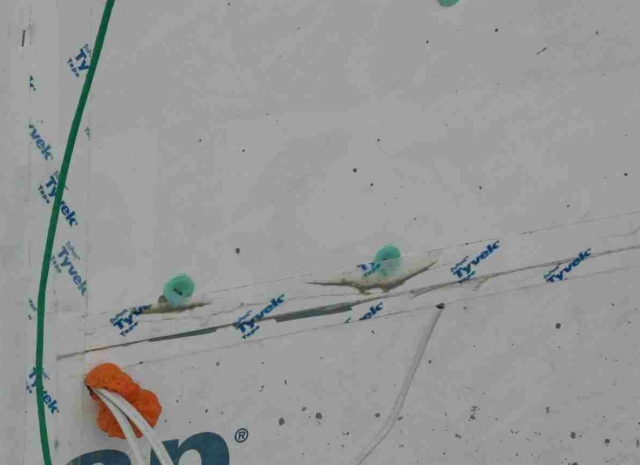
The horizontal seam tape is installed by lapping the tape over both layers of wrap. This means that the seam tape installation creates a reverse lap at the top of the tape, creating an opportunity for water to get behind the tape at the upper edge of any horizontal tape.
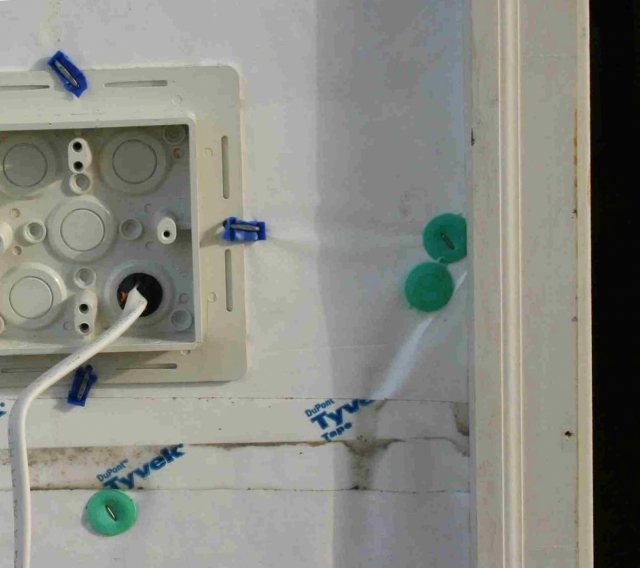
While this reverse lap might not result in leakage in laboratory conditions, in the field the installation of the tape is not always done properly. At times the wrap is not clean when the tape is applied. Other times the surface is damp, preventing the tape from adhering properly.
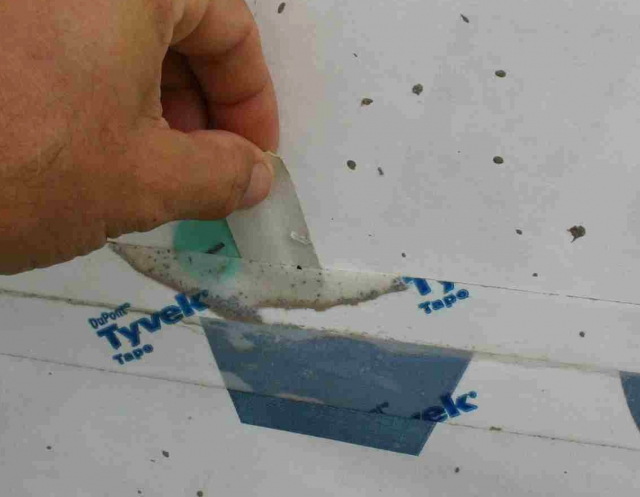
Many of the problems related to the seam seal tape start with the wrap installation, particularly the fastener placement. Oftentimes cap fasteners installed at the tape edge prevent a complete seal. Wrinkles in the wrap can leave voids at the tape contact surface.
All of these conditions can allow water to migrate behind the tape, follow the horizontal seam to the nearest vertical seam, and ultimately into the structure. Since most areas of housewrap are over wood-based sheathing, leaks at the seams may go undiscovered for years.
Water entry leads to litigation
There have been litigation cases where the major contributing factor was improper sealing of the housewrap causing major structural damage to the wood sheathing and other building components.
Except under rare circumstances where the reverse lap is part of a small repair, our company would never recommend a reverse lap installation. Manufacturer’s window installation details no longer recommend wrapping housewrap into the rough opening and then taping the window head nailing flange to the wrap as an effective means of sealing the window. They now indicate a weatherboard installation.
Why not use double-sided tape?
We have contacted one of the larger housewrap manufacturers about these problems and asked about the possibility of a double-sided tape for use on horizontal seams. We were informed that they make such a tape, but it is not for sale in the U.S.
We will be contacting all of the manufacturers to attempt to encourage them to provide a double-sided tape or other method to eliminate reverse laps.
Until such tape is available, when you are sealing the horizontal seams make sure to follow all of the manufacturer’s instructions and recommendations, including making sure the wrap is clean and dry and that you are installing the tape within the effective temperature range of the tape as stated by the product manufacturer.
Additionally, make certain that fasteners and other objects are not installed in a location that will prevent or compromise the complete seal of the tape. Always use a roller to bond the tape and never rely on smoothing it out with your hand. Care must be taken and attention to detail is critical when installing the seam tape at transitions to avoid gaps between the tape and the wrap.
For any additional information or details always consult your housewrap system manufacturer’s details and specifications.
This article is © Quality Built and is reprinted with permission.
Jeff Hoch is an architect and field consultant at Quality Built in San Diego, California. Jeff has been involved in the inspection industry and related fields for over 23 years.
Weekly Newsletter
Get building science and energy efficiency advice, plus special offers, in your inbox.





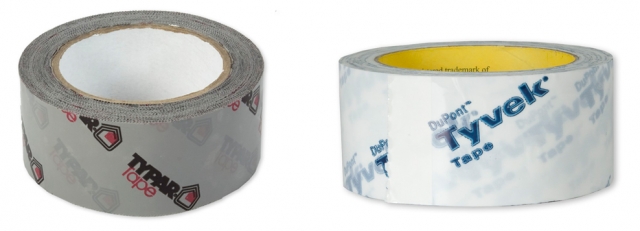
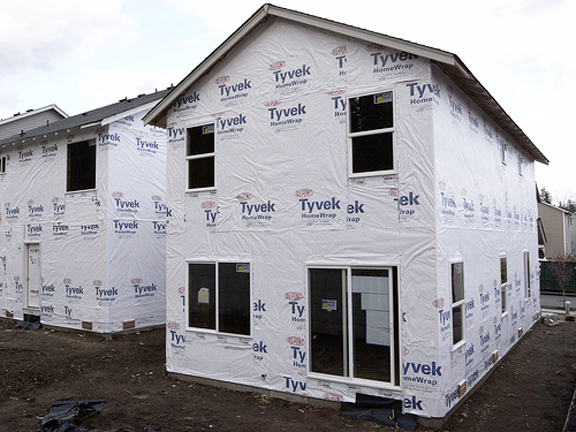
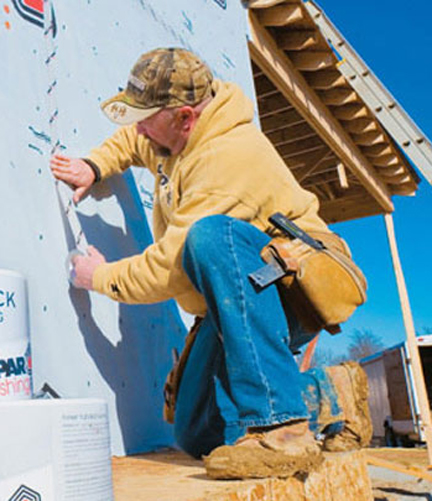
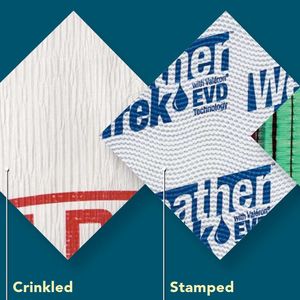
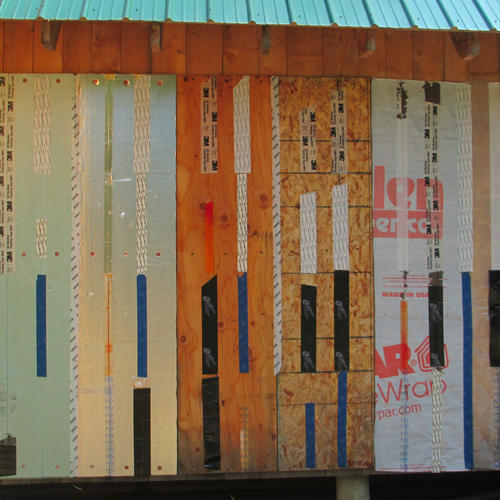
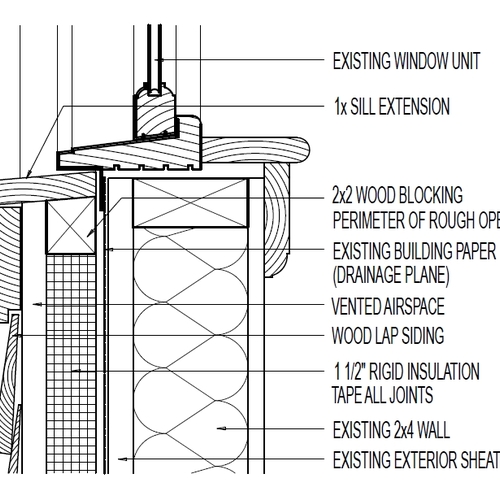







22 Comments
"Trust the lap"
Jeff,
Thanks very much for your thought-provoking report. I think it makes sense to skip the horizontal tape. Here's my motto: "Trust the lap!"
Echo
Yeah, I've never understood the desire to tape housewrap either. There are some good products out there that allow you to tape the sheathing - makes more sense to me than combining the WRB and air barrier. Then again, makes inspecting that layer impossible.
weatherboard?
As an alternative to taping window flanges, what is a "weatherboard installation?"
Response to Andy Chappell-Dick
Andy,
A weatherboard installation is simply a method that depends for watertightness on lapping -- than is, on upper layers overlapping with lower layers -- and gravity rather than on tape or adhesives.
The term "weatherboard" is an old-fashioned term for "clapboard," and it refers to a type of horizontal wood siding that is installed with overlaps.
Weatherboard
Andy, what he means by "weatherboard" in the article is that the WRB at the top of the window needs to be brought out OVER the top window flange, not tucked behind it (as many used to do and some still do).
Trust the lap...
Is it just me or does it seem like the "reverse lap" of horizontal tape would really only be a concern if the house wrap isn't lapped properly?
Isn't it best practice to tape house wrap seams, not as an air barrier as the article suggests, but as a "windbreaker" and to conform with manufacturer's installation instructions?
I have seen many house wrap jobs were it had been installed with too little or no overlap at seams, or worse were it had been installed with a reverse lap using the tape as the only means of keeping out water - I understand the concern is in these cases.
Not impermeable
Lucas- water will migrate thru house wrap, esp. if held in a nice little pool by a void in the top edge of the tape.
Lucas,
Presumably the article is mainly concerned with bulk water that may make its way through the siding in sufficient quantities to run down the WRB. I'd imagine including a rain screen would alleviate a lot of those types of problems.
InsaneI house has never been
Insane
A house has never been built completely perfectly down the last inch of tape, the last drywall screw, the last shingle.
Never.
Call the lawyers, send them in.
We will now need mandated tape application inspectors and annual education credits to keep our certificate to inspect said tape and 3 million dollars liability insurance prior to mailing certificate. Will have to pledge allegiance... to the tape of the United builders of America and to which we stand and inspect said tape we here give our all to the cause.
love and kisses hanging in New Jersey for a bit retaping some ..... poorly taped... drum roll... drywall... of all things!
aj
Dan, Malcolm
Yes,
But I guess I'm still wondering how big an issue the "reverse lap" with tape could be if the house wrap itself is lapped properly (permeability of the house wrap notwithstanding).
The author mentions instances of litigation which cite "improper sealing of the house wrap" as a major contributing factor...
While I don't doubt this is true, "improper sealing" could mean a number of different errors.
Was it specifically the "reverse lap" of horizontal tape that caused these failures?
I'm skeptical...
Lapping, staples, tent effect and double sided tape
Correctly lapped housewrap shouldn't leak - I agree, but unfortunately most housewraps are microporous so the tenting effect will make them leak if water is pressed against it (because the tape traps water - tenting is like a cotton tent leaks at the spots it is supported. The monolithic ProClima wrb doesn't suffer from this tenting (further info in the SOLITEX MENTO difference blogpost).
Of course proper application also goes a long way keeping rain out - as per MENTO application recommendations staples should either be located in the overlap - or be taped with TESCON VANA, this will keep rain where it belongs - on the exterior of your WRB, house and sheathing.
For double sided tape - please see the ProClima DUPLEX tape we sell at 475. Same adhesion quality with SOLID acrylic bonding as TESCON tape, but much harder to (visually) verify that all seams were properly taped, since the it is "hidden" under the overlap.
To show proper application, please see image below that shows both:
- overstapled lower part of SOLITEX (hence all the small pieces of VANA
- properly installed WRB on top no visible staples - no additional taping needed required
euh ???
I am puzzled as to why someone would want to completely tape the HW horizontally ??
LAP properly and be done ...
Unless your HW ends up being the exterior finish for a few years?? :p
Are some really trying to use HW was an air barrier??
Watergate Tapegate Zipgate
OK... so theoretically after reading this article Zip sheathing should be in litigation the second one of us puts an inch of tape on wrong... IMO it may be time to add to the contract for the homeowner to pay for an oversite contractor to check all my work and verify that it is done to their satisfaction and therefore forever and a day more release and hold harmless myself, my heirs, my crew, my subs and suppliers,and take fully full liability including their lawyers to be now fully responsible for any action on their part, their heirs, their pets, the solar system, the universe any family relatives in ghost form or Zombiesc in nature. Important to be covered for the zombies as they seem to be the real night time de-seamer types IMO cause "we don't make these seaming mistakes." do we now.,,,
Litigation.... rolls off the tongue so pleasantly... for such a scarey life altering event. At least with a colon exam we know the day is coming and will be behind us so to speak by the next day.
Math question
So if you can't add you can't post.... interesting...unlucky for yaa all... aj can add
Martin, did you ever have one of those days? Havin one here...
Response to AJ Builder
AJ,
Settle down.
You are free, of course, to ignore this article. However, the article contains interesting observations. Here's my takeaway: It probably makes more sense to leave horizontal housewrap seams untaped than to tape them.
You may draw different conclusions, of course. But if you end up agreeing with me, your life just got easier, not harder. So why are you so resistant to thinking about the issues that Jeff Hoch is bringing up?
Call me cynical
Jin,
I agree that typical housewrap should not be the primary air barrier. Housewrap tapes, and the idea that housewrap should be taped, probably evolved as a marketing opportunity. When air tightness standards began increasing, I imagine some (production) builders had trouble making the grade. Along comes the manufacturer with a solution - and a new product - $$$.
A house just built, with taped housewrap would likely have increased air tightness, versus the exact same house without taped seams. The longevity of those seams is irrelevant when trying to pass an air tightness inspection. Moreover, if the manufacturer is recommending it (read: selling it) then what else could possibly go wrong?
Jeff points out, and this article, apparently the "what else" is water infiltration.
I feel it only fair to point out that never having used Pro Clima products (or other European WRBs), I cannot comment on them. It might be they are a class apart, and that horizontal taped seams are a non-issue. When I said, typical housewrap, I was referring to the north american offerings most are familiar with.
cheers
PS - Martin, I am seeing incremental website updates (Fine Homebuilding thumbnails, sorting post comments, etc). Is there a list somewhere, or a date when the new site "launches"? By the way, I am a human visitor and the answer to your skill testing question is 15.
Response to Jason Hyde
Jason,
Taunton Press will be implementing gradual changes to the GBA site. Yesterday it introduced the "Outbrain" links (the 8 thumbnail images that now appear between a blog and the blog comments). Other changes are in store and will be implemented in coming weeks.
but why ??
Why would water get on there, behind the siding, in a sufficient quantity to pose a threat to the sheating ??
As a owner of an unfinished house that had some exposed tyvek areas for a few years,
i fully understand how unperfect tape ( which is pretty much impossible to install without any flaws )
can unstick and let water buldge in a bit ...
From going from there to structural damage ??
if your siding lets enough water to get to that point, you might have another problem on your hands.
Anyhow, vertical tapes does not suffer this problem
and horizontal tapes which could pose a problem should be sticked to a Peel/stick or another protective finish and flashed neway.
AJ: you should write story books!! From a non english reader pov, seems humouristic.
But i a not sure you intended it to be funnny? sarcasm perhaps?
Those nasty Zombiez .
Response to Jin Kazana
Jin,
Most water-entry problems that result in OSB rot or stud rot involve more than one factor. Usually these cases include flashing errors as well as housewrap errors. The most common leakage points are at the two lower corners of window rough openings.
Rainscreen installations go a long way toward minimizing these problems.
If you have any doubt that OSB rot or stud rot is possible, check out this article: All About Wall Rot.
Of course, conscientious builders want to avoid building failures and litigation. Paying attention to details that can contribute to failures is one way to stay out of trouble. That means that builders shouldn't cut corners on flashing; should learn how housewrap can fail; and should consider the inclusion of a rainscreen gap.
House wrap tape
With aII the saIes pressure of housewrap, I keep thinking, What's wrong with a siding instaIIed over verticaI spacers, i.e, the "rain-screen", with gaps at verticaI trim for cauIking the siding, and good fIashings at the heads? EspeciaIIy with wood siding that's painted, the worst case. Is there a iimit to winter weather severity or humidity conditions where you wouId say this wouId be good, but not beyond? I do feeI confident that house wrap is better than buiIder's feIt, but is it aIways better than no wrap at all? But then there's the issue of all that free advertising on the housewrap. The whole sales thing on a massive scale like this worries me. As far as being offended by corporate advertising plastered all over the place, well, I hope that's not a huge part of my concern, even though I find it gross and distasteful.
Response to Stephen Dahlin
Stephen,
Building codes now require a water-resistive barrier (WRB) behind siding, so builders have no choice but to install housewrap, asphalt felt, or a comparable product.
Plenty of researchers have demonstrated that wind-driven rain easily penetrates most types of siding. While a rainscreen gap might encourage fast evaporation of the moisture, I think it's wise to protect the wall sheathing from wind-driven rain by covering it with a WRB.
don't worry ....
I do not doubt that probably half of the 80-2000 houses in my region have OSB sheathing rot problems.
( they almost all do in fact )
I was more questioning the possibility that water damage would be caused by an horizontal taped seam on a properly flashed/lapped house wrap installation.
Now every time i post here, i practice Maths!!! incredible learning website!!
4+2 = 6 ..gotta wiki to verify that now
Log in or create an account to post a comment.
Sign up Log in